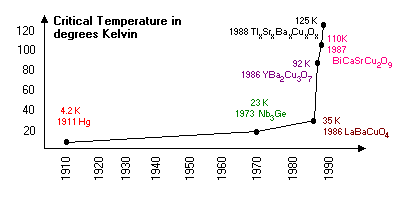
The discovery of high-temperature superconductors (HTS) has created vast interest and an entire industry dedicated to the research and commercial developement of these materials and their applications. International competition is strong in these materials, and current efforts involve many aspects of the electronics, power, medical technology, communications, transportation, and materials processing industries. Many Governments, Corporations, and Universities are investing large sums of money to investigate this major breakthrough that many have hailed as important as the transistor.
Superconductors were first discovered by H. Kamerlingh-Omnes in Holland in 1911 after he cooled mercury down to 4 Kelvin. Shortly after his discovery, new elements such as lead and bismuth were found to have superconductive qualities when exposed to low temperatures. These below freezing temperatures were only made possible by the use of liquid helium. Practical difficulties invloved in the refrigeration process meant that this phenomenon was of mostly theoretical interest until 1986 when new materials were discovered by IBM scientists, George Bednorz and K. Alex Mueller. They discovered that a LaBaCuO (Lanthanum, Barium, Copper, and Oxygen) compound they synthesized in their laboratory superconducted at a temperature over 30 Kelvin. Within a year of their discovery, related materials were found that superconducted above 90 Kelvin. Within two years, the record temperature was over 120 Kelvin. Since it is inconvenient to use negative values when measuring low temperatures of either the Fahrenheit or Celsius scales, temperature measurement of superconductive materials are generally taken using the Kelvin. The formula for the Kelvin scale is as follows:
The amazing thing about superconductors is that there truly is no resistance to direct current (dc). Thus, if one induces an electrical current in a ring made of superconductive material, it will theoretically flow forever. For alternating current (ac), resistance increases slowly with increasing frequency. However, at typical microwave frequencies (in the cellular band, for example) the resistance of a superconductor is perhaps one thousandth of that when compared to the best ordinary conductor. For most practical purposes, this is good as zero. It is certainly low enough to make superconducting radio frequency (RF) components the best in the world.
At present time, thousands of superconductors have been discovered, there are a few that are more common than others. One of the most widely studied and developed of the high-temperature superconductors is YBCO. This compound is made from a mixture of Yttrium, Barium, Copper, and Oxygen. It was the first superconductor discovered with a critical temperature of over 90 Kelvin. Another common compound used in superconductors is TBCCO, which becomes superconductive at a temperature of 128 Kelvin. TBCCO is made of Thallium, Barium, Calcium, and Copper Oxide. It has one of the highest known critical temperatures. Figure 1 has a summary of the giant steps in the field of superconductive compounds.

Cryogenic coolers and cryogenic refrigerators are the most common devices used in the cooling of high-temperature superconductors. Both cryogenic coolers and cryogenic refrigerators are readily available thanks to their usage in the semiconductor processing and aerospace idustries. There are a few differences that need to be taken into consideration when deciding between a cryogenic cooler or a cryogenic refrigerator. The fundamental principal of cooling used in cryogenic refrigerators is the same as that used in home refrigerators. However, rather than using freon as the coolant, liquid helium is the cryogen used in the cooling cycle. Helium is used because it does not condense or freeze at the targeted temperatures of the supercondutor. In addition, helium is environmentallyfriendly, and because it is an inert gas, it is nonreactive and noncorrosive. Cooling in a cryogenic cooler is performed by immersing the superconductive products into liquid nitrogen. There are several advantages in using liquid nitrogen instead of liquid helium. Firstly, the 77 Kelvin temperature of liquid nitrogen is far easier to maintain than the 4.2 Kelvin of liquid helium. Liquid nitrogen also has a much greater capacity to keep things cold than does liquid helium. Most importantly, nitrogen constitutes 78% of the air we breathe, and thus unlike liquid helium, for which there are only a few limited resources, it is relatively cheaper.
 Introduction to Organic Metals
Introduction to Organic Metals Colorado Superconductor INC. (Superconductor Educational Kits)
Colorado Superconductor INC. (Superconductor Educational Kits) Dr.Sridhar's Lab (Norteastern University)
Dr.Sridhar's Lab (Norteastern University) Center for Microscopy and Microanalysis(High-Temperature Superconductors)
Center for Microscopy and Microanalysis(High-Temperature Superconductors) Korea Research Institute of Standards and Science (Superconductivity Group)
Korea Research Institute of Standards and Science (Superconductivity Group) Science & Technology Center for Superconductivity (STCS)
Science & Technology Center for Superconductivity (STCS) University of London (Superconducting Detector Research)
University of London (Superconducting Detector Research) Texas Center for Superconductivity at the University of Houston (TCSUH)
Texas Center for Superconductivity at the University of Houston (TCSUH) Center for Superconductivity Research (University of Maryland)
Center for Superconductivity Research (University of Maryland) Back to Home Page
Back to Home Page
 Back to Published Articles Page. Back to Published Articles Page.
|
 steevn.geo@yahoo.com
steevn.geo@yahoo.com